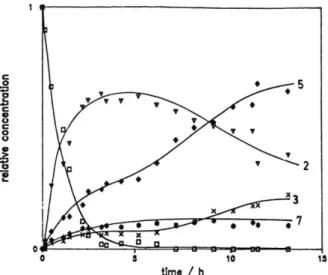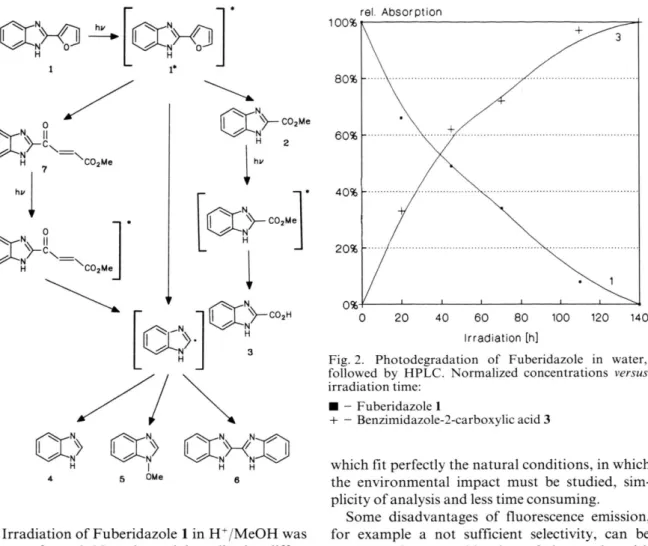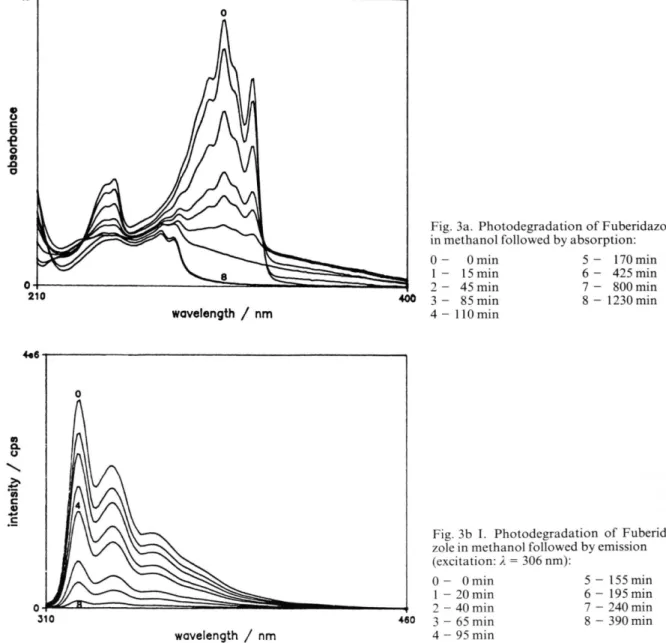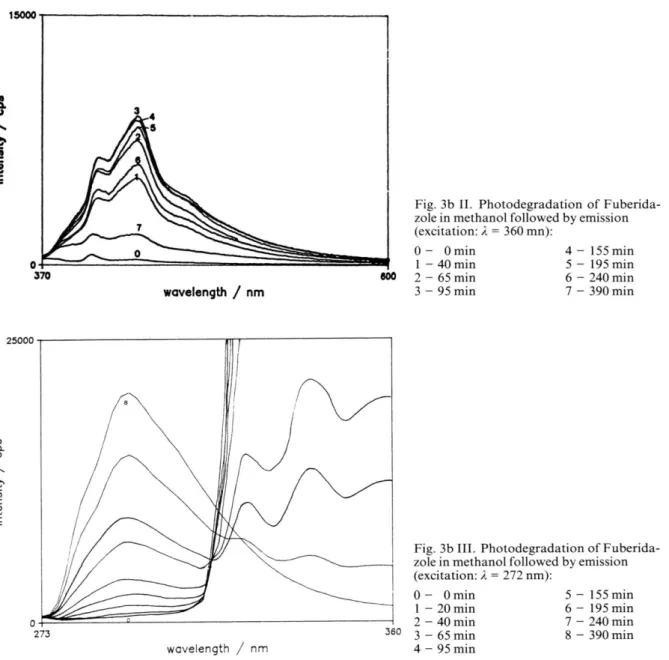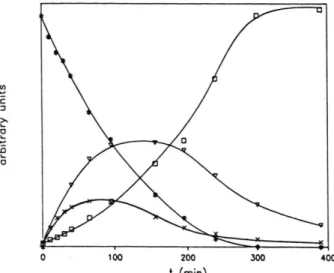Photochemistry of 2-(2-Furyl)-benzimidazole (Fuberidazole)
M. J. Melo, Fernando Pina*Faculdade de Ciencias e Tecnologia da Universidade N o v a de Lisboa, Quinta da Torre, P-2825 M onte de Caparica, Portugal
A ntónio L. M açanita, Eurico C. Melo
Centro de T ecnologia Quimica e Biologica, Quinta do Marques, P-2780 Oeiras, Portugal Christiane H errm ann, R olf Förster, H elm ut K och, Heinrich Wamhoff* Institut für Organische Chemie und Biochem ie der Universität, D -W -5300 Bonn Z. Naturforsch. 47b, 1431 - 1437 (1992); received April 6, 1992
2-(2-Furyl)-benzim idazole, Fuberidazole, Photodegradation, HPLC Separation, Fluorescence Emission
The photodegradation o f 2-(2-Furyl)-benzim idazole (Fuberidazole 1) has been reinvestigat ed em ploying advanced H P L C -U V /V IS technique and fluorescence emission and excitation spectroscopy in m ethanol at natural pH , in acidic m edium and in aqueous solutions at pH 7 and 3, and four main products benzim idazole-2-carboxylic acid 3, its methyl ester 2, 1-methoxy benzim idazole 5, methyl 4-oxo-2-benzim idazole crotonate 7 (cis and trans isomers) besides benzim idazole 4 and 2,2'-bibenzim idazole 6 and other side products have been isolated and characterized. The kinetics o f the photodegradation process was followed independently by H P L C -U V and fluorescence em ission show ing a significant similarity o f the curve habit; this allows to m onitor a photodegradation at very low concentrations ( 5 - 10- 5—5 - 10-6 M). The quantum yield o f disappearance o f Fuberidazole has been determined.
Introduction
Efficient degradation and m ineralization of chemicals used in agriculture is needed to minimize the environm ental im pact of these products, and photodegradation is, am ong the several degrada tion modes, one o f the most im portant. Besides the more or less efficient degradation, it was also real ized in the past the im portance o f knowing the chemical nature o f final degradation products. A complete view o f the problem must take into ac count the form ation and disappearance o f inter mediate products. Such an approach is needed not only for environm ental reasons (a very toxic inter mediate com pound could be very m enacious for the environment, in spite o f its transitory lifetime), but also for understanding the degradation m echa nisms.
Photodegradation o f 2-substituted benzimid- azoles, the most im portant class o f benzimidazoles used in agriculture, has been subject to some atten tion, in particulary some o f us have been involved in first and basic photodegradation experiments on 2-(2-furyl)benzimidazole (Fuberidazole) [1,2].
* Reprint requests to Prof. H. W am hoff. Verlag der Zeitschrift für Naturforschung, D -W -7400 Tübingen
0932 - 0776/92/1000 -1 4 3 1 /$ 01.00/0
Fuberidazol has been m arketed under the trade nam e Voronit* and has been applied as a fungicide [3], as an antihelmintic [4] and against enterovirus es [5]. A lthough the importance o f Fuberidazole has decreased meanwhile, especially this benzimi dazole derivative has proved to be an excellent model com pound for studying abiotic photodegra dation processes in detail with simultaneous sepa ration and identification of the individual photo lysis products by H P L C -U V /V IS separation tech nique combined with a photodiode array detector, as well as for establishing the kinetics o f the p h o to reaction both with H P L C -U V /V IS and with flu orescence spectroscopy; and this com bination opens a novel analytical technique in abiotic p h o todegradation analysis.
The study o f the photodegradation pattern o f in vitro irradiated chemicals is an indispensable step for simulating in vivo photodegradations. In the light of this, we describe the photolysis of F uberid azole in m ethanol solution to exemplify this ap proach to degradation studies. Furtherm ore, we present first results extending these studies to water.
Experimental
Fuberidazole has kindly been m ade available by the Bayer AG, D-W-5090 Leverkusen. The
irra-1432 M. J. M elo et al. ■ Photochem istry o f 2-(2-Furyl)-benzimidazole diation was carried out in m ethanol and water as
solvents in standard immersion photoreactors equiped with high pressure Hg lamps (Philips H PK 125W) and pyrex filters (to cut-off wave lengths lower than / = 313 nm. The different pho toproducts were separated by a W aters HPLC-sys- tem with a R P lg-column (NucleosilR, Macherey- Nagel, 250 mm x 4 mm) and detected by a tunable U V -detector (W aters 484) and a photodiode array detector (W aters 990). F o r high-resolution mass spectrometry a A.E.I. K ratos MS 50 (70 eV, DE 150 °C) was used.
H PLC chrom atogram s were recorded using the following acetonitrile-water eluent gradient (flow:
1 ml/min): Time (min) Acetonitrile (%) Water (%) 0 12 88 3 12 88 15 50 50 19 50 50 22 12 88 30 12 88
All H PLC -grade solvents used were purchased from Riedel-de Haen. A bsorption spectra were re corded on a Perkin-Elm er Lam bda 6 and fluores cence emission and excitation spectra on a Spex F i l l Fluorolog. All emission and excitation spec tra were corrected. F o r quantum yield m easure ments (10-5 to 10~ 6 M) light excitation at X = 313 nm was provided by a medium-pressure Hg lamp from M üller Optik, the excitation wave lengths being selected with filters from Oriel. The incident light intensity 1.1 x 1 0 “ 6 Einstein-m in“ 1
was m easured by ferric oxalate actinom etry [6]. The photodegradation products were character ized by high resolution mass-spectrometry of the separated peaks, UV-spectra and com parison with authentical samples (preparative column chrom a tography and independent preparative synthesis). Results and Discussion
Photodegradation kinetics monitored by H P L C Fuberidazole 1 was photolyzed in m ethanol so lutions at natural pH. The solution was m onitored during irradiation time by HPLC. The area o f the several chrom atographic peaks observed at the ab sorption wavelength o f X = 254 nm was divided by the relative m olar absorptivity to obtain
propor-£
10 tim e / h
Fig. 1. Photodegradation o f Fuberidazole in methanol, follow ed by H PLC. N orm alized concentrations versus irradiation time:
□ - Fuberidazole
V
#
- Product 3, retention time o f 3.75 min, benzim idazole-2-carboxylic acid - Product 2, retention time o f 16.18 min,
methyl benzim idazole-2-carboxylate - Product 5, retention time o f 18.25 min,
m etoxy- 1 -benzim idazole - Product 7, retention time o f 19.69 min,
m ethyl-4-oxo-2-benzim idazole-crotonate
tionality with concentration, and plotted as a func tion o f time (see Fig. 1).
This shows the form ation o f four main prod ucts, which were identified as being benzimid- azole-2-carboxylic acid (3, retention time of 3.75 min), methyl benzimidazole-2-carboxylate (2, retention time of 16.18 min), 1-methoxy-
benzimidazole (5, retention time o f 18.25 min) and methyl 4-oxo-2-benzimidazolecrotonate (7, reten tion time of 19.69 min). Benzimidazole 4, 2,2'-bi- benzimidazole 6, a c/s-isomer o f 7, and a methanol adduct C ]2H10N2O 3-M eOH (not identified) were also detected in low concentrations. The observed products and their kinetic pattern can be account by Scheme 1. The photoproducts 2, 4, and 7 have been found in our previous work employing colum n chrom atography [1], while 3, 5, 6, the cis- isomer of 7 and the m ethanol adduct have been only now detected by employing the much more sensitive H PLC -technique [2].
M. J. M elo et al. ■ Photochem istry o f 2-(2-Furyl)-benzim idazole 1433 rel. A b s o r p tio n
CO"-“’“*
C 02Me \ > - C 0 2HCO CO 0 X 0
Irradiation o f Fuberidazole 1 in H +/M eO H was also performed. N o substantial qualitative differ ences were observed, when com pared with the same experience at natural pH , besides the differ ent relative am ount o f the several photoproducts. A completely different result was obtained for the irradiation of Fuberidazole in water at pH = 3.0, as is shown in Fig. 2. U nder these conditions, F u beridazole 1 decays to give a m ain product, which was identified as being benzimidazol-2-carboxylic- acid.Photodegradation kinetics fo llo w ed by absorption andfluorescence emission
Absorption and particulary fluorescence emis sion are two powerful high sensitive analytical techniques to be used for routine analysis in kinet ic studies of photodegradation o f chemicals. F o r fluorescence emission the advantages result espe cially from the very low concentration limits,
20 4 0 60 80
Ir r a d ia tio n [h]
100 120 140
Fig. 2. Photodegradation o f Fuberidazole in water, follow ed by HPLC. N orm alized concentrations versus irradiation time:
■ - Fuberidazole 1
H— Benzim idazole-2-carboxylic acid 3
which fit perfectly the natural conditions, in which the environm ental im pact must be studied, sim plicity o f analysis and less time consuming.
Some disadvantages of fluorescence emission, for example a not sufficient selectivity, can be overcome by a com bination o f the results with those obtained by HPLC.
M ethanolic solutions of Fuberidazole (5 • 10-5 to
5 - 10“ 6 M) at natural pH , air degassed by nitrogen circulation, were irradiated with a wavelength of k = 313 nm, and m onitored by electronic absorp tion (high concentration limit), Fig. 3 a, and fluorescence emission (low concentration limit), Fig. 3 b.
The evolution of the fluorescence emission spec tra as a function o f time was obtained for an exci tation wavelength of k = 306 nm, where F uberid azole is the largely dom inant emissive species in solution, and for this reason, Fig. 3 b shows the disappearance of the title com pound. F o r different excitation wavelengths, other patterns are ob served, including increase of fluorescence emission due to form ation of photoproducts, as is shown in Fig. 3 b for an excitation wavelenght of k = 360 nm
1434 M . J. M elo et al. • Photochem istry o f 2-(2-Furyl)-benzim idazole and Fig. 3 b for an excitation wavelength of X =
272 nm.
W henever it is not possible to select an excita tion wavelength for which only one species is emis sive (it depends on the overlap o f its absorption spectra with other emissive species present in solu tion), an increase on selectivity can be achieved by choosing the appropriate emission wavelength (it depending on the fluorescence emission spectra overlap), allowing to measure exclusively the emis sion o f the species studied.
In Fig. 4 is shown a practical example of the procedure described above. The Fuberidazole de cay curve is distinctly obtained at the wavelengths o f X = 306, and 324 nm for excitation and emis sion, respectively. By a criterious choice of differ ent excitation and emission wavelengths we were able to obtain curves for some other photoprod ucts.
In spite o f the similarity of the curves describing the kinetic patterns o f Fuberidazole photodegra dation obtained both by HPLC and fluorescence
210
Fig. 3a. Photodegradation o f Fuberidazole in m ethanol follow ed by absorption:
400 wavelength / nm 0 - 0 min 5 - 170 min 1 - 15 min 6 - 425 min 2 - 45 min 7 - 800 min 3 - 85 min 8 - 1230 min 4 - 110 min
Fig. 3b I. Photodegradation o f Fuberida zole in methanol follow ed by emission (excitation: X = 306 nm): 0 - 0 min 5 - 1 5 5 min 1 - 20 min 6 - 195 min 2 - 4 0 min 7 - 240 min 3 - 6 5 min 8 - 390 min 4 - 9 5 min wavelength / nm
M. J. M elo et al. • Photochem istry o f 2-(2-Furyl)-benzim idazole 1435
wavelength / nm
Fig. 3b II. Photodegradation o f Fuberida- zole in methanol follow ed by emission (excitation: X - 360 mn): 0 - Omin 4 - 155 min 1 - 40 min 5 - 1 9 5 min 2 - 6 5 min 6 - 240 min 3 - 9 5 min 7 - 390 min 25000 273 wavelength / nm
Fig. 3b III. Photodegradation o f Fuberida- zole in methanol follow ed by emission (excitation: X = 272 nm): 0 - Omin 1 - 20 min 2 - 4 0 min 360 3 - 65 min 4 - 9 5 min 5 - 1 5 5 min 6 - 1 9 5 min 7 - 240 min 8 - 390 min
emission, Fig. 1 and Fig. 4 respectively, some dif ferences were observed which m ay be attributed to the different characteristics o f the two analytical m ethods. The interm ediate species described in Fig. 3 was followed by m onitoring the excitation and emission wavelengths a t X = 360, and 435 nm in Fig. 4, respectively. Excitation spectra o f this species were also obtained at the emission wave length of X = 460 nm (to avoid interference of other emissive products), and the spectra obtained
is consistent with the form ation o f com pound 7 or some of its isomers, Fig. 1.
The photoproduct observed by following the photochemical reaction at the excitation wave length of X = 272 nm, Fig. 3 b (III), was represent ed in Fig. 4, at the maximum emission wavelength (X = 295 nm). The shape o f the emission spectra and also the excitation spectra (for a wavelength emission of X = 295 nm) is consistent with benz- imidazole 4 or 1-methoxy-benzimidazole 5.
a rb it ra ry u n it s
1436 M. J. M elo et al. • Photochem istry o f 2-(2-Furyl)-benzim idazole
t (min)
Fig. 4. Kinetic curves o f Fuberidazole photodegrada tion follow ed by fluorescence emission:
# - excitation X - 306 nm, emission X = 324 nm V - excitation X - 360 nm, em ission X = 435 nm □ - excitation X = 272 nm, em ission X = 295 nm
x - excitation X - 340 nm, em ission X = 360 nm
A third photoproduct was observed by choosing the wavelengths of A = 340, and 360 nm for excita tion and emission, respectively. This product was not clearly identified due to the overlap of its emis sion spectra with those o f Fuberidazole 1 and pho toproduct 7, while rough spectra of emission, ob
tained upon subtraction of the two interferences mentioned before, could suggest to be 2,2'-bibenz- imidazole 6.
The irradiation o f Fuberidazole in aqueous so lution at pH = 3.0 was as well followed by flu orescence emission, Fig. 5. In agreement with the results obtained by H PLC , we observed the disap pearance o f Fuberidazole and the form ation of just one photoproduct, whose excitation spectra is consistent with the com pound identified by HPLC to be benzimidazole-2-carboxylic acid 3. In this particular case the two m ethods detect the same photoproducts and we can take profit of the very low concentration limits available, when fluores cence emission is used.
Quantum yields measurements
Q uantum yields m easurem ents for Fuberidazole disappearance in m ethanol, were obtained at A = 313 nm (Table I).
Table I. Quantum yields for Fuberidazole disappear ance in methanol at X = 313 nm.
PH o 2 n2 Quantum yield [0 ]
Natural + - 1.3* 10-4
Natural - + 4.7 x 10“4
Acidic (H C 104) - + 4.9 x 1 0 '3
Fig. 5. Photodegradation o f Fuberida zole in aqueous solution follow ed by fluorescence em ission and U V-visible absorption:
□ - excitation X = 314 nm, em ission X = 340 nm,
M. J. M elo et al. • Photochem istry o f 2-(2-Furyl)-benzim idazole 1437 The results reported in Table I indicate a
quenching by 02 on the quantum yield for Fuberid azole disappearance, which is a strong indication to attribute the triplet as the reactive species. In air equilibrated acidic aqueous solutions we obtained a quantum yield <P o f 9.Ox 10~4.
Photochemical mechanism
The chemical nature o f the photoproducts re sulting from the photodegradation o f F uberid azole, (all of them containing the benzimidazole ring), points to the furane ring moiety as the exclu sively reactive p art o f the Fuberidazole molecule in the excited state. A nother inform ation arises from the kinetical pattern o f the photodegradation curves, which show the form ation o f methyl benz- imidazole-2-carboxylate 2 as the m ost im portant pathway of photodegradation. It is known from the photochem istry o f furane and methyl substituted furanes, that cyclopropenyl ketone acts as an in term ediate in the conversion to products [6, 7]. In that light a possible mechanism to account for the form ation of methyl benzimidazole-2-carboxylate 2 could proceed through a similar cyclopropenyl ketone transient 8, followed by reaction with methanol to give the final compound, see Scheme 2.
The other product, methyl-4-oxo-2-benzimid- azole-crotonate 7 can be explained by a photoas- siste ring cleavage. Benzimidazole 4, 2,2'-bibenz- imidazole 6 and 1 -methoxybenzimidazole 5 are obviously formed by reaction of the benzimidazole radical. Such a radical can be formed directly from our proposed transient 8, or through the second ary photochem ical reactions.
W hen water is used as the solvent, a similar mechanism may be considered: the form ation of benzimidazole-2-carboxylic acid 3 resulting from the attack o f the transient cyclopropenyl ketone 8 by water.
Conclusions
Inspection of Fig. 1 indicates th at for a long time upon complete disappearance o f Fuberid azole, there is still a lot o f degradated interm ediate products. Particulary some o f them m ay be consid ered to have a longer lifetime when com pared with Fuberidazole, and their persistence in soils and natural waters is greater than the target molecule.
Such a behaviour illustrates our assum ption, that the simple analysis o f a photodegradation curve of a chemical is not sufficient to follow their environmental impact, and points to the need of more detailed studies.
This work was supported by the Fonds der Chemischen Industrie, the Bayer A G, and by the J.N .I.C .T.-Portugal under C ontract N o. PM C T/ CEN 658/90.
Financial Support of this G erm an-Portuguese Project by the Commission of the E uropean C om munities, C ontract N o. STEP-0043 is gratefully acknowledged.
[1] M. R. Mahran, M. M. Sidky, and H. W amhoff, Chemosphere 12, 1653 (1983).
[2] C. Schulten, D iplom arbeit, U niv. Bonn (1991). [3] Farbenfabriken Bayer A G (Inv.: P. E. Frohberger,
C. W iegand), Ger. 1.209.799 (1966); C. A. 64, 14900 g (1966);
A. Frank, A cta Pharmacol. Toxicol. Suppl. 29, 124 (1971); C. A. 70, 139676s (1971);
J. F. Jenkyn and R. D . Prew, Ann. Appl. Biol. 75, 241 (1973); C. A. 8 1 ,488u (1974).
[4] G. L. D unn, P. A ctor, and V. J. D ilasquez, J. Med. Chem. 9, 751 (1966);
Merck & Co. Inc. (Inv. J. J. N etta, J. R. Egerton) U .S. 3.549.754 (1970); C. A. 74, 146378d (1971). [5] I. Tamm, H. J. Eggers, R. Bablanian, A. F. Wagner,
and K. Folkers, N ature 223, 785 (1969).
[6] S. Boue and R. Srinivasan, J. Am. Chem. Soc. 92, 1824(1970).
[7] E. E. van Tamelen and T. H. W hitesides, J. Am. Chem. Soc. 90, 3894 (1968).
